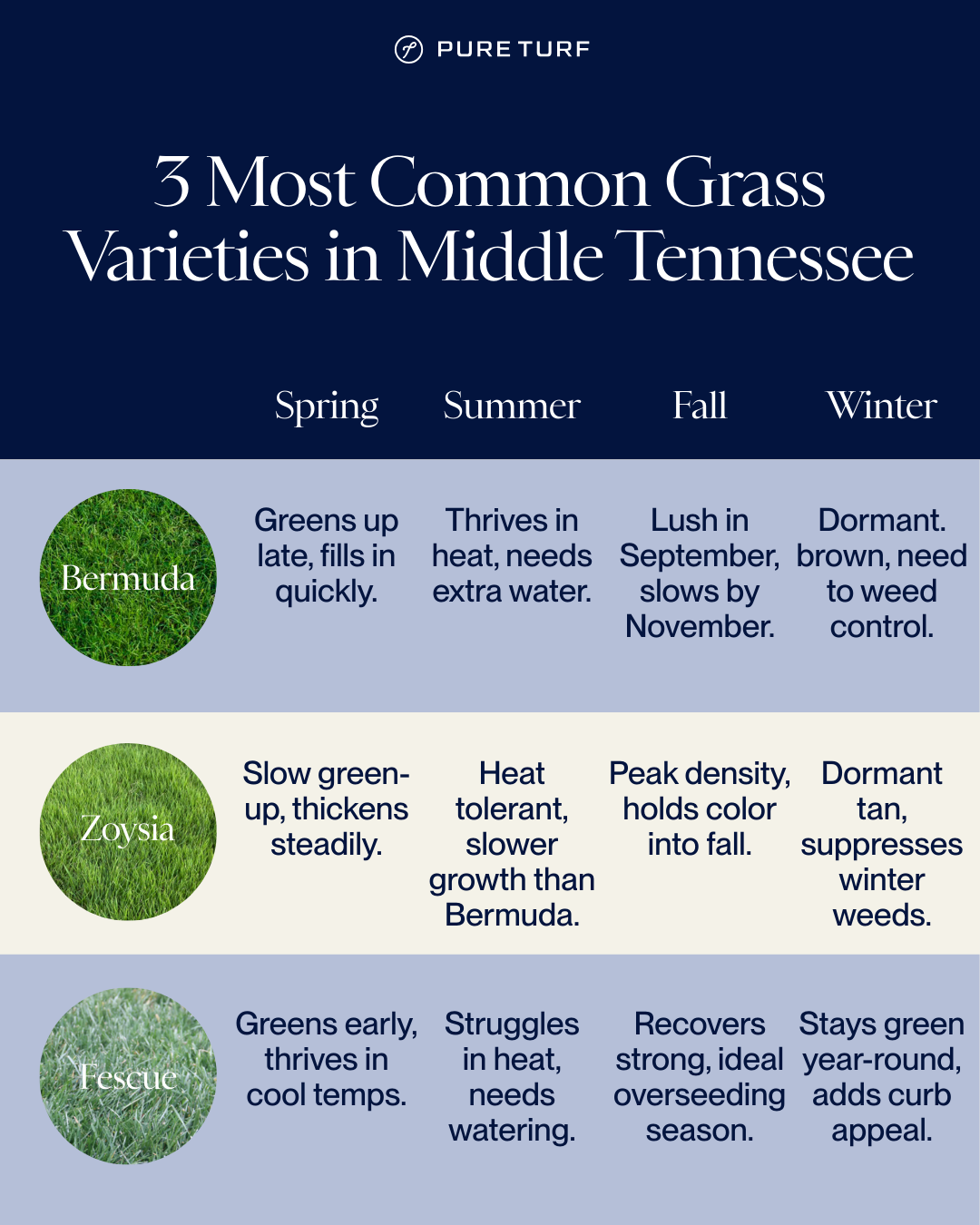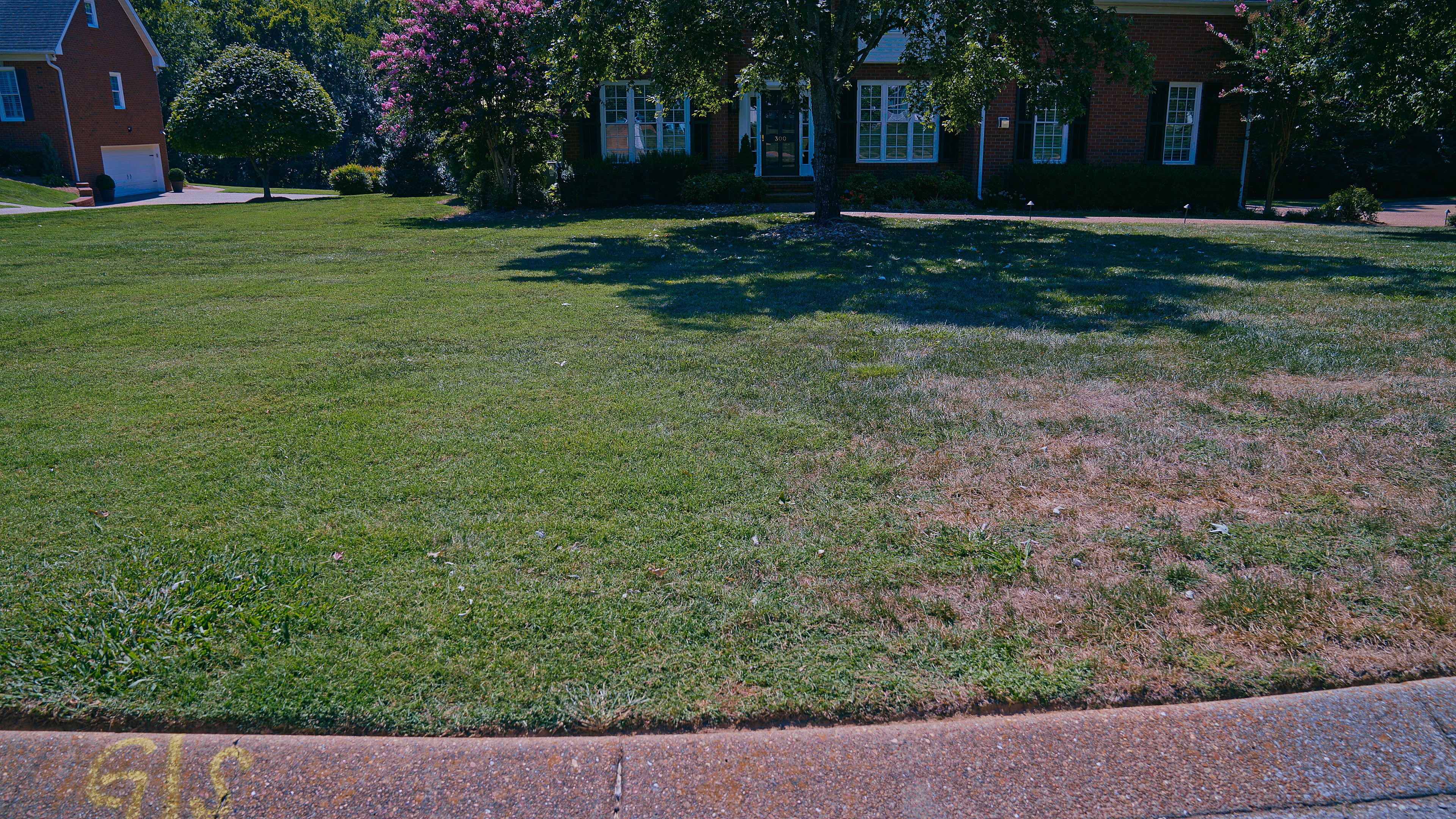
September in Middle Tennessee brings a noticeable shift. The summer heat begins to ease, mornings feel crisp, and lawns across the region start showing off their best color and growth. If you’ve been paying attention, you’ve likely noticed Bermuda and Zoysia lawns looking especially vibrant this time of year.
But why do these grasses thrive in September? And how can you make sure your lawn looks this good year-round? Let’s dig into what makes Bermuda and Zoysia shine in the fall and how Pure Turf can help you keep your lawn healthy in every season.
Bermuda Grass: Thriving as Summer Fades
Bermuda grass is one of the most popular warm-season grasses in Tennessee, and for good reason. It loves heat and sunshine, which means it typically looks its best from late spring through early fall.
By September, Bermuda is still actively growing but enjoying a reprieve from the scorching July and August heat. Cooler nights paired with warm days create the perfect environment for Bermuda to recover from summer stress and show off a lush, green appearance.
Why Bermuda looks great right now:
- Late-season vigor: With soil still warm, Bermuda is actively photosynthesizing and filling in any thin patches.
- Less stress: Cooler temps and reduced drought stress mean fewer brown spots and less wilting.
- Weed suppression: A thick Bermuda lawn at this stage crowds out opportunistic weeds, keeping the turf uniform.
The result? A dense, carpet-like lawn that holds up well to foot traffic during fall sports, backyard cookouts, or kids playing outside after school.
Zoysia Grass: Durable and Beautiful
Zoysia grass, another warm-season favorite, is known for its durability and fine texture. In Middle Tennessee, Zoysia tends to peak in beauty late summer into early fall.
Like Bermuda, Zoysia thrives on warm soil and long days of sun. By September, its slow-growing but steady nature produces a dense turf that feels almost soft underfoot. Unlike Bermuda, Zoysia tolerates shade better, so it’s an excellent choice for lawns with partial tree cover.
Why Zoysia looks great in September:
- Peak density: After months of steady growth, Zoysia forms a thick, lush mat.
- Color retention: Zoysia tends to hold its green color longer into fall than Bermuda, making it a standout this time of year.
- Resiliency: Its dense growth pattern makes it more resistant to weeds, insects, and disease pressure.
Zoysia lawns this month often look their very best—deep green, plush, and healthy—making September one of the most rewarding times for Zoysia homeowners.

Fescue Grass: The Year-Round Option
While Bermuda and Zoysia are warm-season grasses, Fescue is the cool-season champion of Middle Tennessee. Fescue doesn’t love the extreme summer heat, so many lawns look stressed in July and August. But by September, Fescue begins to bounce back in a big way.
Cooler nights and shorter days trigger Fescue’s peak growing season. Fall is also the ideal time to aerate and overseed Fescue lawns, ensuring a fresh start and filling in any thin or bare spots from summer.
Why Fescue looks great in September:
- Recovery mode: After summer dormancy, Fescue greens up quickly with cooler weather.
- Overseeding success: New seed germinates best in September, creating a thicker, healthier lawn.
- Seasonal strength: Unlike Bermuda and Zoysia, which go dormant in winter, Fescue stays green year-round, giving your lawn curb appeal even in January.
For homeowners who want consistent green through all four seasons, Fescue is the go-to choice in Middle Tennessee.
Comparing the Three Grasses
Here’s a quick look at how Bermuda, Zoysia, and Fescue stack up each season.

The best grass for your lawn depends on your goals, your property’s sunlight exposure, and how much maintenance you want to commit to. Many homeowners in Middle Tennessee even combine grass types, using Fescue for shade-heavy areas and Bermuda or Zoysia for sun-drenched spaces.
September Lawn Challenges
Even though lawns look great in September, this is also a pivotal month for setting them up for long-term success. Without the right care, warm-season grasses can thin out before winter dormancy, and cool-season grasses may not recover fully from summer.
Common September lawn challenges include:
- Weed pressure: Opportunistic weeds like crabgrass and spurge can sneak in as grasses slow down.
- Soil compaction: Summer activity compacts soil, making aeration critical this month.
- Insect activity: Grubs, armyworms, and other pests can damage roots and thin out turf.
- Disease outbreaks: Fall humidity can trigger brown patch or dollar spot, especially in Fescue.

Addressing these issues now helps ensure that your lawn doesn’t just look great in September, but continues to thrive into winter and beyond.
How Pure Turf Can Help
At Pure Turf, we specialize in taking care of lawns all year round. Our proven lawn care programs can give you a healthy, thriving lawn no matter the season. Whether you have warm-season grass or cool-season grass, our team is ready to help.
Our Basic, Essential, and Elite programs include everything your lawn needs, from fertilization and weed control to insect treatments and aeration. We also offer lawn disease prevention and overseeding benefits to ensure your lawn stays healthy during the colder months.
With a Pure Turf proven program, you will see results within weeks and a full transformation within 8-12 months. Our programs include the following treatments:
- Fertilizer & Weed Control
- Lawn Disease Prevention
- Insecticide Treatments
- Aeration & Overseeding Benefits
The following services can be added on to your Basic program:
- Lawn Disease Prevention (included in an upgrade to Premium)
- Mosquito and Tick Control
- Tree & Shrub Health
Plus, our services include a liquid soil conditioner that improves your lawn’s health year-round. If you’re looking for more specialized care, we can also add mosquito and tick control, as well as tree and shrub health treatments.
Request a free estimate today and let us help you get your lawn ready for winter. We’re here to make sure your lawn is healthy, vibrant, and ready to shine in the spring.


.jpg)

